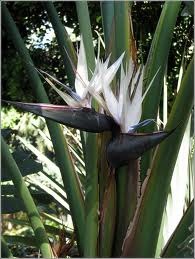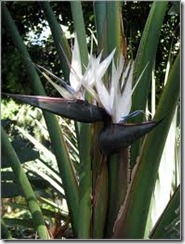Native to South Africa, the bird-of-paradise gets its name from of the resemblance to a brightly colored bird in flight. The flowers are made up of blue petals and orange sepals emerging from a bract (modified leaf) that blooms intermittently throughout the year. According to MyKindaLiving.com, they produce approximately 36 flower spikes each year.
- Choose a sunny or partially shady location for your birds-of-paradise. If in a shadier area, the plant will grow taller and produce larger flowers; growing in a sunnier location will cause the plant to be shorter and have smaller flowers. While this plant can handle temperatures down to 24 degrees Fahrenheit for short periods of time, avoid planting it if your area has below freezing temperatures for extended lengths of time. This can damage developing buds, and it is probably best to grow a bird-of-paradise in a container so it can be moved indoors during the winter months.
Although this plant can grow well in many types of soil, it will thrive in a good-quality organic soil with good drainage. If necessary, till the garden area and mix in an organic potting soil. According to the University of Florida’s IFAS Extension, the hole should be about 2 to 3 times larger than the diameter of the root ball and only as deep as the root ball is tall.
Water the plant well before removing the container. After removing the plant from the container, sit it in the hole so the top of the root ball is level with the surface, and fill in with soil, patting gently.
Watering and Fertilizing
- Water the plant well to remove any air pockets and settle the soil around the root ball. Create a shallow basin around the diameter of the plant to hold water while it soaks down into the soil. For the first 6 months, water well, keeping the soil moist. During the warmer months this may mean watering several times a week or even daily if the soil is drying out quickly. In the winter, watering 2 to 3 times weekly is sufficient.
To feed your plant there are several options that can be used: an organic fertilizer such as manure, time-released plant food or granular fertilizer. Spread the fertilizer around the base of the plant about every 3 months during the growing season from spring through fall. No need to fertilize in the winter.
Mulching and Pruning Hints
- Applying a layer of mulch around your plants helps to retain moisture, reduce weeds and regulate the temperature of the soil. You can use organic material such as leaves, pine needles, bark or wood chips. Gravel and crushed stones also work well. When applying keep the mulch about 2 to 3 inches away from the stem of the plant to avoid increasing the chances of stem rot.
Pruning is only needed to remove dead leaves and old flower stalks. This can be done any time of the year.


Deprecated: strpos(): Passing null to parameter #1 ($haystack) of type string is deprecated in /home/agriviek8Qv/agriviet.net/public_html/wp-includes/comment-template.php on line 2522